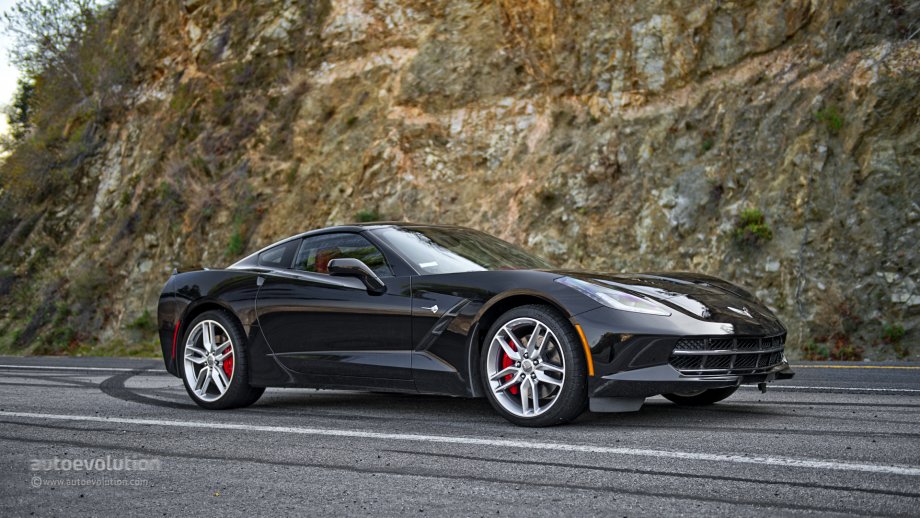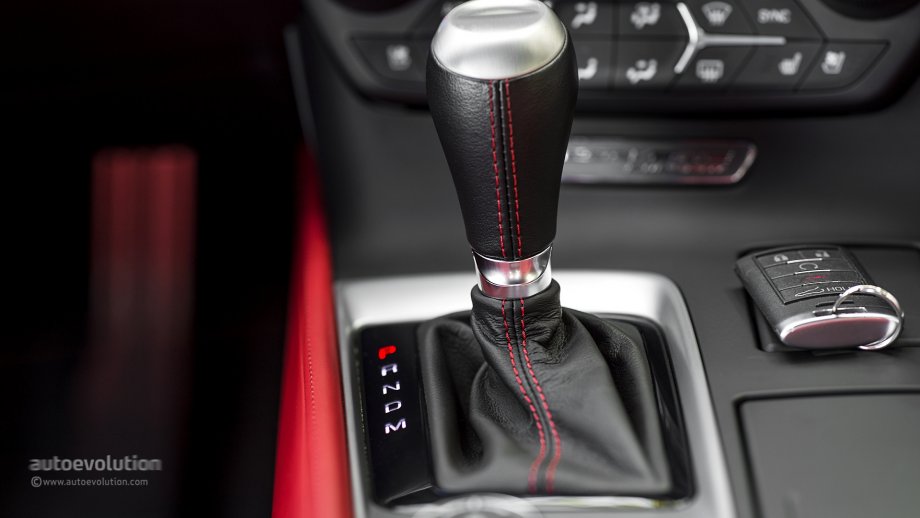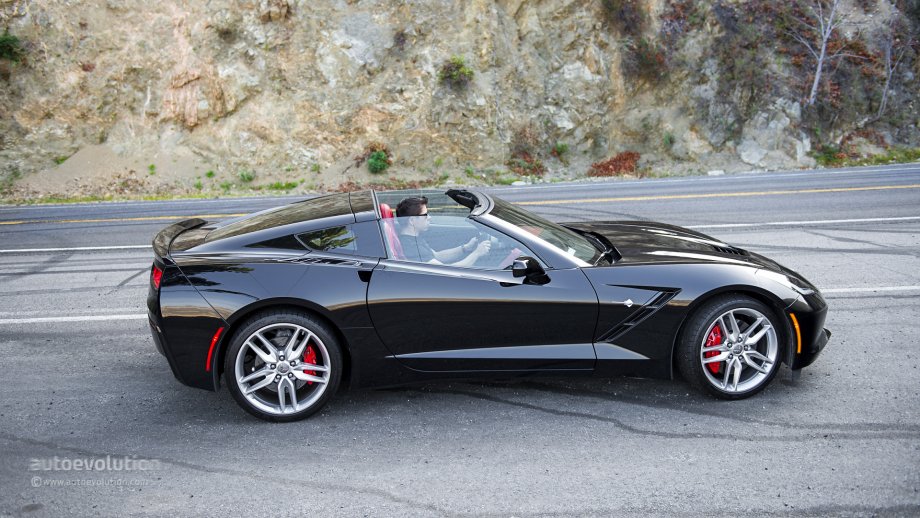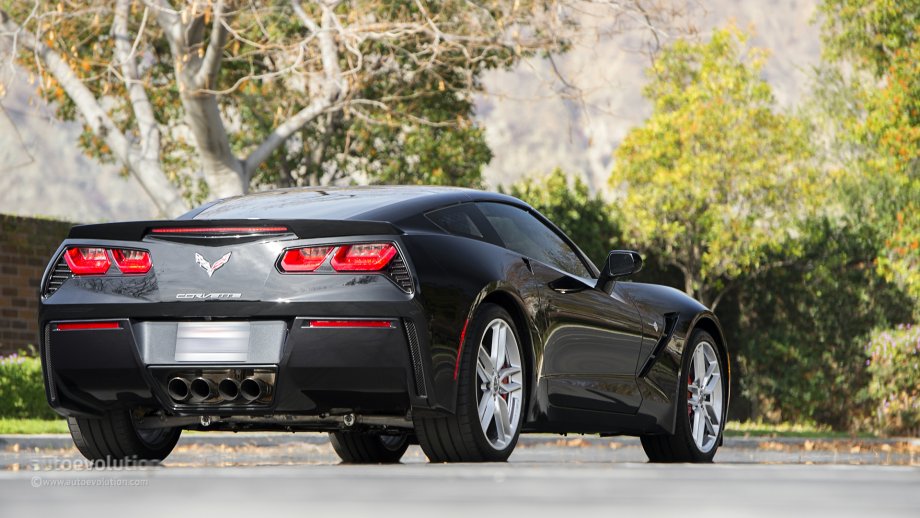|
just can't get enough
Drives: a bunch of fast toys...
Join Date: May 2012
Location: SoFla
Posts: 3,605
|
C7 reviewed/tested by Autoevolution (Excellent read & pics)
A loooong read but a well-done review and road test.... plus many nice photos!
--------------------------
autoevolution article & 114 photos: http://www.autoevolution.com/testdri...2014.html#sjmp
 
Santa Claus does indeed exist - this is what GM is trying to prove with the 2014 Corvette Stingray. The ‘Vette had started to become a bit arrogant, offering plenty of performance, but asking you to make multiple compromises in the process of extracting this. Well, with this new one, they promise everything has been made more accessible.
Chevrolet brags that the seventh incarnation of its flagship brings a complete experience. Being able to fully enjoy performance motoring everyday sounds like Christmas morning all throughout the year, so we’re all ears for this story.
Then again, it was in the Stingray’s genes to try and reinvent the franchise. That’s because the original Stingray, which was the second generation of the car, did exactly that. GM wasn’t even convinced if it had to build the Corvette in the beginning and so the first one was a bit of an experiment. When the Stingray arrived in 1963, it changed the game altogether, whether you were keen on design or engineering.
Speaking of engineering, General Motors has been working on the C7 Corvette ever since 2007 and meanwhile they’ve gone as far as considering a switch to the mid-engined layout.
Well, the engine is still up front, but, like we said, the engineers are trying to convince us that’s about the only thing that remained unchanged.
Our request for the optional Z51 Performance Package was fulfilled, so we approached the car with confidence.
Before we set off, let’s take a bit of time to analyze the C7 Corvette’s appearance. From the very beginning of the car, the change is obvious - the headlights now run up onto the hood.

The thing looks muscular and a bit like a Transformers character at the same time, with the proportions being spot on. Alas, as you reach the rear end, the controversy makes its way onto the table. It’s all about those taillights. Yes, the quad setup is here, but they’re angular and pressed together. We’re pleased with the styling of the Corvette, but there is room for improvement.
Nonetheless, the upgrades under the skin are even greater. We have to start with the aerodynamics, where the C7 takes lessons from the C6.R racer. For example, that air vent on the hood isn’t there just for the show. Sending hot air out of the hood minimizes front axle lift.
If you order either an automatic transmission, or the Z51 Performance Package, the vents on the sides become functional. The left one cools the transmission, while the one on the right is there to keep the temperature of the limited slip diff in check. Once the air cools the aforementioned elements, it exits the car via the vents surrounding the rear lights.
Our tester has the full-size rear spoiler, part of the Z51 kit, which, aero-wise, also includes extra brake cooling and extra air deflectors.
Most of the Corvette’s steel unibody has been swapped for an aluminum structure. The chassis is not just 99 lbs (45 kg) lighter than the previous model’s one, but also 57 percent stiffer. The wheelbase has grown by about one inch, while the front and rear tracks being expanded by the same value.
In the same respect, the hood and removable top are made of carbon fiber. The Corvette keeps its fiberglass body panels, but there’s a new compound that makes these even lighter. They’ve even worked underneath the car, where we find carbon-nano composite panels.
Along these panels, we find a completely reworked aluminum suspension. The short-long arm architecture is maintained, but the lower front arms are now hollow (-9 pounds/4 kg), while the rear toe links trade steel for aluminum (-2.4 pounds/1.1 kg).
The saved weight was consumed on the extra mechanicals, such as variable displacement and high tech hidden within the car, so the end result weighs about the same as before. Chevy’s Corvette has a curb weight of about 3,300 lbs (1,500 kg). Nonetheless, that weight is evenly distributed between the axles (50:50).
There are lots of new tech things to make public, but it’s time to lower ourselves into the 2014 Corvette Stingray’s cabin now. Oh my, what a pleasant surprise!
The interior has always been a bit of an Achilles's Heel for the Corvette, but not anymore. They’ve redesigned everything sans the air filter and the top panel latch. As soon as you enter, the driver focus becomes clear. The man in charge gets two thirds of the cabin, with his passenger being clearly constrained to his remaining bit. It’s not so much a matter of space, as one of respect. This is a clear indication that the Corvette is a much more of a sports car than a GT.
Despite the place on the right not coping to well with a passion for cheesecake, the person there does get a dedicate set of climate controls placed on the right, complete with its own screen.

The cockpit is wrapped around you and, as soon as you enter, you notice that you’re surrounded with technology. The driving position keeps you poised, with great credit going to the redesigned, smaller steering wheel. As for the seats, you can choose between two versions, both using magnesium frames: GT and Competition Sport.
We prefer the GT accommodation and don’t think that this lacks lateral support. Even in this case, the bolsters are heftier than what the C6 Corvette had to offer.
When it comes to the dashboard, this holds HD fully-configurable display, flanked by basic-looking analogue dials reminding of the Corvette’s tradition.

To the right, there’s a second HD infotainment display, very easy to use and read. You can even slide this down to reveal the rather generous “secret stash” behind. Another nice trick is the Head Up Display, which is nicely placed in your field of view - this is located in the curve formed between the right wing and the power dome on the middle of the hood.
The ergonomics receive a high score, except for the center console. Here, the shifter and the drive mode selector seem to be place a bit too much towards the back. Operating them will sometimes make your passenger think you deliberately touched elbows with him or her.
During all this time, you sit in an environment that’s covered in premium materials, from leather to aluminum and carbon fiber.
As for the removable carbon top, you can detach and handle this all by your own. You do have to pay attention though, especially when placing it back on the car, so as not to scratch the body. When you’re in the mood for it, the roof can be placed in the generous boot. The latter measures 15.9 cubic feet (450 liters) and you’ll still be able to use it once the top is stowed. By the way, you can also have the panel in a two-piece form or a transparent one. It’s all a matter of dipping into the list of options.
Playing with the C7 Corvette’s roof makes that of the Lamborghini Aventador Roadster seem like a joke. A bad one.

Alas, as somebody closes the hatch, you’ll feel a bit of an ear slap. Chevrolet wanted to get all fancy with the bits that let the air out of the cabin, but we weren’t all that pleased with the result. So be a gentleman and handle your own hatch.
You’ll have the opportunity to do that each time you go shopping, which, by the way, you can in the C7. This Chevrolet has no problem in being used as a daily driver and this means it’s rather civilized within the city’s limits.
The electromechanical steering is light at these city speeds and the ride is decent. Even if you choose the Z51 Performance Pack, which brings a stiffer setup and skip its optional Magnetic Ride Control, the conclusion still stands.
For the record, the sportier suspension configuration means going from 35 mm-piston dampers to 45 mm ones, both supplied by Bilstein. Along with this, you also get thicker stabilizer bars. And if we are to compare the Z51 to the SRT Viper (passive vs. passive damping), the Corvette is the more civilized one. Things obviously turn the other way around in terms of body roll, but it’s not like the Stingray has more than a microscopic hint of that.
On city roads, the visibility is basically the only thing that keeps you in a leash. It’s a pity then that those frugal door mirrors won’t cooperate too much.
The powertrain may be ferocious when you drop our right foot, but right now we’re driving this with almost the same ease as a Malibu. All hail the driving modes. There’s five of them: Weather, Eco, Tour, Sport and Track. These because they interfere with 12 variables, from steering effort and throttle mapping, through traction control, to the things displayed on the dash.
You can scroll between them using the switch on the center console. While it does take some time getting use to this controller, each of the mode brings out completely different manners of the Chevrolet Corvette C7. Except for Track, the car starts in the mode you left it in, unlike most other vehicles of its kind.
Given this, we don’t know why they didn’t go all the way with the tech and skipped a start-stop system. After all, even Ferraris have such options nowadays.
Despite other engines on the market offering start-top in conjunction with cylinder deactivation, Chevrolet only offers the latter. Yes, the all-new LT1 V8 up front features active fuel management. If you get an automatic, the V4 mode can be active in any of the aforementioned driving modes, while manual vehicles only have this active in Eco.
It’s quite a cool piece of kit this new LT1. Using 6,162 cc of displacement, it delivers 455 HP at 6,000 rpm, but the real treat is the torque. 460 lb-ft (624 Nm) arrive at 4,600 rpm. Between 1,000 and 4,000 rpm, the LT1 offers the same torque as the ex-generation Z06’ 7.0-liter LS7 unit. For instance, while a Ferrari 458 Italia gives you 250 lb-ft (339 Nm) at 2,000 rpm, this powerplant serves 400 (542 Nm). To achieve this, the unit features direct injection and variable valve timing.

And that torque and power are being put to good use. The 0 to 60 mph sprint takes 3.8 seconds, while the quarter mile readings show 12 seconds flat at 119 mph (191.5 km/h). As for the top speed, this sits at 190 mph (306 km/h).
We simply can't help but mention the aforementioned figure are a child's play for the aftermarket world, which has already taken twin-turbo 2014 Corvettes into the 9s quarter mile territory.
Power is harnessed through a steel torque tube, which, together with special engine valves, has the role to make the engine run steadily in V4 mode. At the back, we find a transaxle arrangement, which can house a Tremec TR6070 seven-speed manual or an updated version of the C6 Corvette’s 6L80 six-speed automatic. Both come with paddles. While the latter does that for obvious reasons, the first uses these to allow the driver to activate or deactivate its rev-matching function. The hardware goodies also include a dual-disc clutch.
Opt for the Z51 Performance Pack and you’ll get an electronically-controlled limited slip differential, dry-sump oiling for the V8, as well as the extra cooling and aero elements we’ve mentioned above. We’re particularly fond of the eLSD, which sports a hydraulically-powered clutch for splitting the power.
We tackled the city in Tour, but we’ve switched to Sport as the road opened up ahead of us. The first indication of this is a livelier exhaust note. You can choose between two systems, both offering active layouts with butterfly valves. Basically, you need the beefier one to feel the full character of the car, but the standard system also does a decent job.
If you don’t like the dedicated dashboard light, you can use the exhaust quiet to tell when you’re only using four pistons. If you use the standard system, you’ll have to apply quite some throttle to awaken the sound, as it’s rather discrete in daily use. Nonetheless, once you do this, once of the sweetest American voices emerges from the hefty mufflers placed on the center of the car, just below the trunk floor.
At first, we drove the automatic and we have to tell you that the six speed tranny is the weak technical link of the Corvette. This box does pretty well in terms of comfort, but when it’s dynamics you’re looking after, you’ll feel it’s lacking that final high-end performance. The paddles are easy to use, but it doesn’t rushes to shift and the changes themselves are not all that fast.
Oh and there’s something else - whenever you use the paddle in a hurry, it sounds like you’re having a champagne toast... in plastic glasses. We know the ‘Vette goes easy on your budget, but this kind of details require dedication, not necessarily more money. We really, really wish the list of options would include the 8L90 eight-speed automatic introduced on the fresh Z06 version of the C7 Corvette.
Nevertheless, we’re running out of patience, as we’re eager to see what the new steering setup brings. The electric assistance sounds like bad news, but they’ve went to great lengths to make up for the lesser feedback. If we must talk figures, we’ll tell you that the steering column is now 150 percent stiffer, while the intermediate shaft gets a mind-blowing 600 percent torsional stiffness boost - if you are a C6 Corvette owner, don’t read the paragraph above.
The feedback is decent (still, nowhere near that in a Porsche), but the thing is that the steering feels right. While we appreciated its cooperation in the city, it gains just the right weight when you activate the right mode and increase the speed.
By the way, you can set up the level of steering assistance and the exhaust mode independent from the driving profiles. When it came to the steering, most of the drive found us in “Auto”.
Once you lean in on the car through the twisties, you’ll notice that the 1g cornering ability of the Z51 Pack feels exactly as it should. You can drive this thing hard and you can do it with extreme precision. And if you’re willing to drift it, it’ll be happy to oblige, stepping into an easily controllable slide. The steering is quite eager on the turn-in and the car gets back on the power quick, even though even the Track Mode won’t convince it to be perfect in terms of aggressive throttle response.

Just like the 2014 Corvette Stingray has multiple personalities in general, driving it fast also reveals its multi-faceted character. It’s amazing how the same car can mix high-end precision handling with a wild, untamed nature. Brilliant!
As for the obvious comparo, Chevrolet’s Corvette doesn’t feel as thoroughbred as the Viper, but you perceive it as being lighter on its feet. Oh and if you’ve ever considered pitting the Corvette against a BMW M6, forget it. Aside from the two extra seats in the M6, the German is light years behind.
No. Of course the Chevrolet Corvette isn’t perfect. For instance, when the electronics are fully on, they interfere rather harshly. As we applied full throttle mid-corner, the car kept going on and off the power to stay on track, instead of using a more gradual transition. Fortunately, the day is saved once you use the right driving mode.
Once again, the Corvette Stingray treats this with a lot of technology. In terms of electronics, you get Active Handling, or StabiliTrack stability control, if you may. In the Sport and Track driving modes, this offers a Competitive mode that allows just enough of a slip angle to let you have fun before it steps in. Double-click the Driving Mode Selector when in Track to get some info.
In the end, you can live with the six-speed automatic though.

Still, if you do wish to switch to the manual, you’ll have a pleasant surprise. The Automatic Rev Matching function is brilliant. There are special sensors which “feel” where the shifter is going. Thus, the system reacts quicker, as it doesn’t have to wait for a certain gear to actually be engaged, like others of its kind do.
As with Tremec’s six-speed manual, the clutch engages high in its travel, so you don’t risk accidentally launching the car. As for the pedal action itself, you can get used to its necessities.
Regardless of the transmission choice you make, that LT1 V8 is one nicely-dressed brute. Actually, it feels like you have two engines in one. Up to 3,000 rpm it’s a civilized naturally-aspirated unit. Past this point, the muscle start arriving faster and faster, as if there was a miniatural supercharger hidden under that vented hood.
This all means that on the highway, the Corvette isn’t necessarily the car that pushes you to hit the pedal, like the Viper does, for example. And thanks to the increased wheelbase and tracks, the thing is stable. Its natural state right now is to cruise peacefully and you could use the C7 Corvette for a cross-country drive without breaking a sweat.
Oh and all the fuss about boosting fuel efficiency hasn’t been in vain. The official figures place the Corvette Stingray at 17 mpg city and 29 mpg highway. Our “Touring” highway drive returned 28 mpg, while a more spirited behavior made the dash say 21.4 mpg. Nice.
Even with the Corvette’s run-flat tires, the ride stays manageable and, if you switch to the adaptive dampers, things become pretty good. Since we mentioned the rubber, we have to explain that the C7 doesn’t follow the usual growth trend. Its Michelin Super Sports use the same diameter as the tires on its predecessor, but they’re narrower (one inch up front and two at the rear). Chevrolet claims that the rubber was developed specifically for the C7, so it manages to deliver a similar level of grip.

The standard car rides on 18x8.5-inch front wheels and features a 19x10-inch size at the back. The Z51 brings a 19x8.5-inch size up front and a 20x10-inch size at the rear.
The aforementioned state of cruising is maintained as we make a right, heading up to a deep canyon road. You can enjoy the Corvette without having to hammer it, but only after you’re past five out of ten.
The C7 Corvette also uses Performance Traction Management, which, you guessed it, is offered in Sport and Track modes. Of course, it’s always nice to send all those nannies home and play with the naked beauty of the chassis.
And if you feel that the corner up front is approaching too fast, you can rely on the brakes anytime. The standard system features 12.6-inch (320 mm) front rotors and 13.3-inch (338 mm) rear rotors. These are over one third larger in terms of swept area compared to the C6, so the C7’s stopping distance goes down by 9 percent.

We enjoyed using the 13.6-inch (345 mm) front rotors and 13.3-inch (338 mm) slotted rear rotors of the Z51 Performance Package. This compared to the C6’ Gran Sport version, which is outbraked by 5 percent. The modulation is suitable for all sorts of situations and there’s serious stopping power.
We end the drive with another series of open-top moments, well, just because we can. Up to 65 mph (100 km/h) the Corvette keeps the wind outside. You can truly enjoy the car’s charms, as well as its audio delights. The latter arrive via an optional Bose ten-speaker system including a bass box and two subwoofers. Mind due, you will have to keep the sun visors up to receive full draught protection.

At the end of the day, the C7 Corvette Stingray manages to make all your wishes come true. This ability to serve as a daily driver, high performance vehicle and... brute makes up the best part of the car. All these assets arrive as the result of the tons and tons of engineering that have went into the Stingray.
It’s also easy to drive, whether we’re talking about commuting or abusing the pedal on the right. If you get one and your girlfriend asks to borrow it, don’t be afraid to say “yes”, this can be a unisex car. Just make sure she keeps it in the right driving mode and don’t try to hold us responsible for what happens next.

At least she’ll have a great time inside, as the cabin is no longer the Corvette’s ugliest side. The interior of the 2014 Chevrolet Corvette has come a long way from those of its predecessors, despite still falling short of perfection.
As you may have noticed, we’ve been comparing the 2014 Corvette to the SRT Viper throughout the review. Well, the truth is the two are not all that close. The Stingray only shows its raw, visceral face when you drive it hard, whereas the Viper has that on all the time. This is the worst part of the new Corvette - you remember this car rather thanks to the applications of its technology than thanks to a certain thoroughbred feeling.
Then again, trying to drive a Viper everyday is amusing. And we mustn’t forget the price gap between the two - the Viper’s financial burden is double compared to that of the ‘Vette. All discussions end here, at least until the supercharged C7 Corvette Z06 arrives in dealerships.
The Chevrolet Corvette starts with a MSRP of $51,995 (+$2000 as of 3/1/14) to which you really have to add the $2,800 (+$1200 as of 3/1/14) Z51 Performance Package. A clear ten in the value for money race then, this thing is (still) a bargain.
Of course, things are a bit different in Europe. The Old Continent sees the Corvette starting at EUR69,990, plus VAT, with the Z51 Pack being offered as standard. Even so, the Chevrolet Corvette still make a lot of sense.
And while the comparison with the Porsche 911 is rather useless (the two will never share customers), the Corvette is actually pretty close to Ferraris. The American and the Italian share the sports versatility. Even the Corvette’s dashboard instrument cover and headlights make us think of the Prancing Horse. Before we settle into the conclusion that GM took inspiration from Fiat, we have to explain that the American way may be better.
The California would probably be the closest model in Ferrari’s range. Well, at least until we get to drive the new California T, we’d choose the Corvette without blinking. It is the better car here. Even when compared to the 458 the Stingray proves a mighty adversary, especially of we factor in the pricing.
What else? Audi R8? Jaguar F-Type?
We’d take the Chevrolet Corvette any day. 

|





